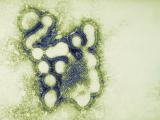Nov 4, 2011 (CIDRAP News) – The US Centers for Disease Control and Prevention (CDC) today reported two more infections with swine-origin H3N2 influenza, including a case first announced by Maine 3 days ago and an additional illness in an Indiana patient.
The CDC also said flu activity in the United States is still at low levels, a pattern the World Health Organization (WHO) is also seeing in most parts of the world.
The new cases raise the nation's number of infections involving a swine-origin H3N2 virus that contains the M gene from the 2009 H1N1 virus to seven. Both patients had exposure to pigs, and there is no evidence of a link between the patients or any human-to-human transmission, the CDC said in a statement. Both patients have recovered.
The Indiana State Department of Health (ISDH) said its laboratory identified the virus on Oct 28 and forwarded it to the CDC, where genome sequencing confirmed the triple-reassortant H3N2 virus. The patient had very close contact with pigs the week before he or she got sick, and no illnesses have been reported in the patient's household or contacts, according to a statement.
The finding represents Indiana's second infection involving triple-reassortant H3N2 with the M segment gene from the 2009 H1N1 virus. The first was in a child whose illness was detected in July.
So far all of the patients had direct contact with pigs, except one who had a caretaker who had been exposed to pigs. The CDC said it is continuing to monitor the implications of the genetic change, which it said likely resulted during swine coinfection with swine H3N2 influenza and the 2009 H1N1 virus. It said that though most novel influenza viruses don't result in human-to-human spread, the cases should be monitored closely to identify any possible transmission and reduce further exposure.
In other developments, flu indicators stayed low last week, the CDC said. Doctor's visits for flu-like illness were below the national baseline, and though deaths from pneumonia and flu increased slightly, they were still at an expected level for this time of year.
The percentage of respiratory specimens that tested positive for influenza rose to 0.9%, up by 0.1%, and no states reported widespread, regional, or local influenza activity,
The CDC said its analysis of the few flu isolates that have been submitted so far shows that all three flu subtypes are circulating.
On the global front, the WHO said today that flu activity in the Northern Hemisphere's temperate regions remains low and few cases have been reported in in South Africa and South America.
A few tropical locations are reporting increased or ongoing flu activity, the WHO reported. Nicaragua is reporting a sharp increase in 2009 H1N1 infections. Meanwhile, flu activity, most of it H3N2, in Honduras and El Salvador is decreasing.
Surveillance in flood shelters in Thailand indicates that the most common illness detected is flu-like illness, and the country's surveillance system has reported large numbers of H3N2 and influenza B infections, the WHO said. In other tropical parts of Asia, low levels of influenza B activity are occurring.
Flu levels are declining in temperate areas of South America, and in Australia and New Zealand the flu season is mostly over, though different regions are still reporting variations in timing and subtype detections.
See also:
Nov 4 CDC influenza update
Nov 4 CDC statement on novel H3N2 cases
Nov 3 ISDH influenza report
Nov 4 WHO global flu update




















